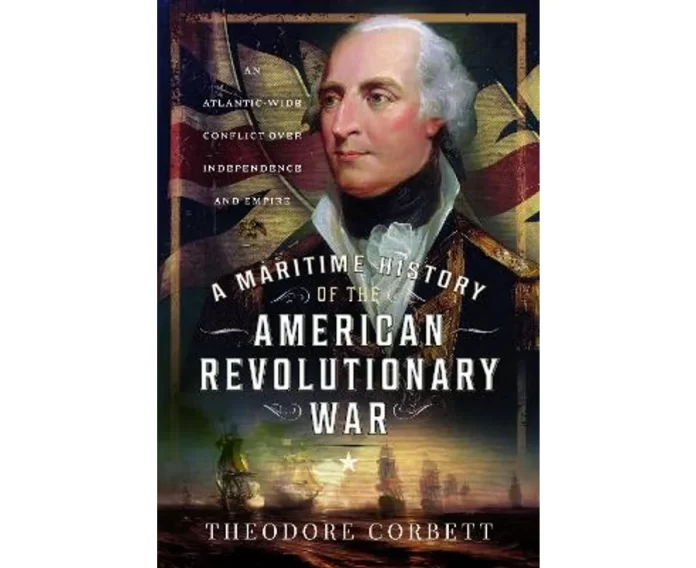
A Maritime History of the American Revolutionary War: An Atlantic-wide conflict over independence and empire. By Theodore Corbett. Pen and Sword Maritime, Barnsley, South Yorkshire and Haverstown, 2023. (ISBN 978 1 39904 041 9)
Reviewed by John Johston
The American revolutionary war is usually seen as a conflict on land, in which the only significant naval actions were John Paul Jones’s raids on the British coasts between 1777 and 1779. But, as Theodore Corbett demonstrates in this well-documented study, the ability of the British to sustain the war rested on naval power.
The impressive network of supply bases and dockyards which had been developed since the 1700s spread across the Atlantic, from the mouth of the Thames to the Caribbean and Nova Scotia and allowed the British to hold their ships on station and withdraw them for maintenance and repair in theatre rather than back across the ocean.
With the Atlantic effectively their base area, the British could repel the American assault into Canada, blockade the coasts from Maine to Georgia, and launch amphibious operations to take New York, Philadelphia, Charleston, and Savannah. However, they could not simultaneously conduct campaigns in America and confront the loose alliance of European powers which provided the colonists with material and later with armed support. Ultimately, they would be vulnerable if they should lose command of the seas or the inland waters.
Whilst the colonies could not match the scale of British capabilities, they could draw on the shipyards and merchant fleets of New England to create a navy which raided British waters and entered European ports under the flag of the newly proclaimed republic. The raids by John Paul Jones and others were more theatrical than tactical, but they showed that the republic was a state in being and just not a collection of rebellious colonies. That success enabled agents like Benjamin Franklin to lobby the courts of Europe to recognise the republic and allow purchases of munitions and supplies, which the navy and privateers brought back across the Atlantic.
At the same time, individual colonies created their own navies which operated inshore and in the confined waters of Chesapeake Bay and along the Delaware River. The British responded with patrols carried in barges, but they could not expand their areas of control nor protect loyalists in coastal villages and settlements from reprisals by colonial militias and others. With the British having publicly lost control of territory beyond their outposts, loyalists, freed blacks, and escaped slaves and their families fled into British-held cities, increasing the numbers of people under British control, but not British capabilities or territory.
As more and more European powers were drawn into the conflict, the British became increasingly isolated and were less able to obtain the stores, materiel, and timber they needed to sustain the fleet, while the deployment of French troops and ships in support of the Americans altered the balance of strength in theatre. The collapse came more rapidly than expected. In October 1781 the army in Virginia was encircled at Yorktown. The French fleet got between it and the relieving British squadrons, forcing the Royal Navy into a humiliating withdrawal and the army into a no less humiliating surrender.
To compound British woes, the Spanish laid siege to Gibraltar and the French fleet, released from American waters after Yorktown, deployed to the West Indies. The British, however, held Gibraltar through strictly controlled convoy duties and in-theatre improvisation, which ensured that they did not lose control of the sea lanes from Great Britain or the waters around the Rock. As for the French fleet, it was dispatched in a devastating cannonade of concentrated firepower and vengeance in the battle of the Saints.
Soon afterwards, Britain and its European enemies concluded a peace treaty and the British began evacuating their army and the civilians who had sought their protection. The evacuees included freed blacks and escaped slaves, whom American leaders like George Washington demanded be returned to their former owners. The British commanders simply refused to consider such claims and took the evacuees – black and white – to the Bahamas, Bermuda, England, and Nova Scotia, thus preserving British honour, if not reputation.
The most interesting aspects of Corbett’s study, however, lie behind the narrative in the tactical and organisational innovations which the British and the Americans made in response to a changing tactical environment. To fight in the narrow waters of Lake Champlain and Chesapeake Bay, for instance, the British replaced sailing vessels with oar-propelled barges and tenders. Likewise, the Americans overcame the disintegration of the continental navy by licensing privateers to run the British blockade on supply operations, a concept that is akin to that of the private military company today.
Yet, whilst the account of campaigns at sea and on inland waters adds to our understanding of the war, the presentation of events is also a reminder that the war of American independence was a revolutionary war, that British were conducting a war of counter-insurgency, and that lessons from the eighteenth century have resonance in the twenty-first. Historians will be thankful to Corbett for illuminating an overlooked aspect of the past, but naval and military planners might reflect on how losing command of the sea led to the two largest surrenders in the history of British arms: Yorktown in 1781 and Singapore in 1942.



